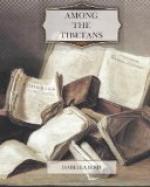Between Gya and Darcha, the first hamlet in Lahul, are three huge passes, the Toglang, 18,150 feet in altitude, the Lachalang, 17,500, and the Baralacha, 16,000,—all easy, except for the difficulties arising from the highly rarefied air. The mountains of the region, which are from 20,000 to 23,000 feet in altitude, are seldom precipitous or picturesque, except the huge red needles which guard the Lachalang Pass, but are rather ‘monstrous protuberances,’ with arid surfaces of disintegrated rock. Among these are remarkable plateaux, which are taken advantage of by caravans, and which have elevations of from 14,000 to 15,000 feet. There are few permanent rivers or streams, the lakes are salt, beside the springs, and on the plateaux there is scanty vegetation, chiefly aromatic herbs; but on the whole Rupchu is a desert of arid gravel. Its only inhabitants are 500 nomads, and on the ten marches of the trade route, the bridle paths, on which in some places labour has been spent, the tracks, not always very legible, made by the passage of caravans, and rude dykes, behind which travellers may shelter themselves from the wind, are the only traces of man. Herds of the kyang, the wild horse of some naturalists, and the wild ass of others, graceful and beautiful creatures, graze within gunshot of the track without alarm, I had thought Ladak windy, but Rupchu is the home of the winds, and the marches must be arranged for the quietest time of the day. Happily the gales blow with clockwork regularity, the day wind from the south and south-west rising punctually at 9 a.m. and attaining its maximum at 2.30, while the night wind from the north and north-east rises about 9 p.m. and ceases about 5 a.m. Perfect silence is rare. The highly rarefied air, rushing at great speed, when at its worst deprives the traveller of breath, skins his face and hands, and paralyses the baggage animals. In fact, neither man nor beast can face it. The horses ‘turn tail’ and crowd together, and the men build up the baggage into a wall and crouch in the lee of it. The heat of the solar rays is at the same time fearful. At Lachalang, at a height of over 15,000 feet, I noted a solar temperature of 152 degrees, only 35 degrees below the boiling point of water in the same region, which is about 187 degrees. To make up for this, the mercury falls below the freezing point every night of the year, even in August the difference of temperature in twelve hours often exceeding 120 degrees! The Rupchu nomads, however, delight in this climate of extremes, and regard Leh as a place only to be visited in winter, and Kulu and Kashmir as if they were the malarial swamps of the Congo!




